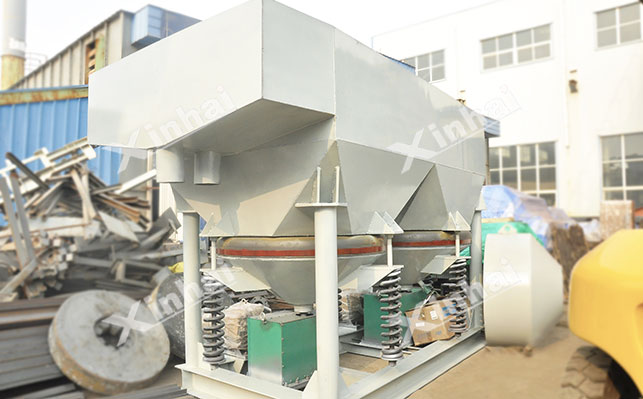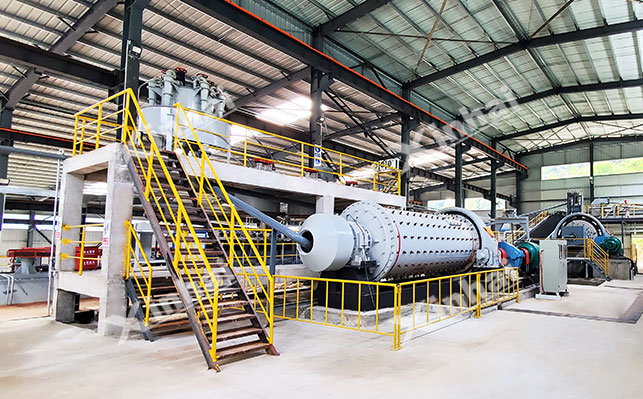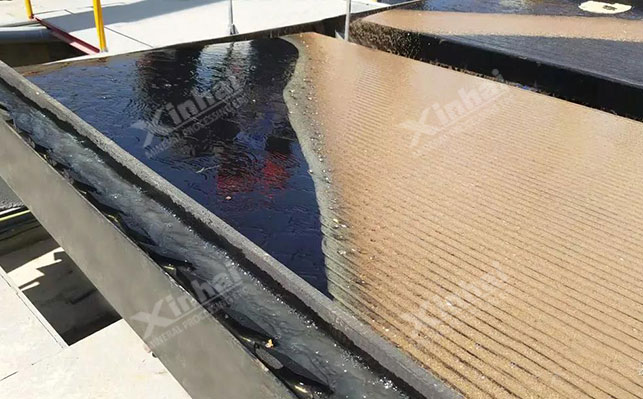
15311826613
Click to add WeChatGravity separation is one of the main means of rock gold ore beneficiation, especially suitable for processing coarse-grained and high-grade rock gold ore. In the beneficiation process, grinding particle size, as a key factor in the gravity separation process, directly determines the dissociation and gravity separation efficiency of minerals. So in the gravity separation process, what are the requirements of different gravity separation methods for particle size? In this article, we will analyze and answer from multiple angles!

Gravity separation is a beneficiation method based on the density difference between different mineral particles in gold ore, under the action of gravity, fluid power and other mechanical forces, to achieve mineral particles stratification and separation according to density. In gold ore gravity separation technology, the commonly used ones are jigging gravity separation, shaking table gravity separation and chute gravity separation. Among them, jigging gravity separation is a method of using a jig machine to achieve layered separation according to density differences through vertical pulsating water flow, which is suitable for processing coarse-grained materials; the shaking table uses asymmetric reciprocating motion and lateral water flow to finely separate the ore particles, which is often used to recover fine gold; the spiral chute uses the movement characteristics of the ore particles on the rotating spiral surface to achieve separation according to density and particle size, and has a good separation effect on fine-grained materials.
Since rock gold mines are mainly composed of natural gold, pyrite, quartz and other minerals, gold is often embedded in the gangue minerals in the form of granules, flakes or inclusions. Its density is quite different from that of the gangue ore, and gravity separation can effectively separate the two. Compared with gold separation methods such as flotation and cyanidation, gravity separation technology does not require the use of a large amount of chemical agents, has little environmental pollution, meets the requirements of green mine construction, and can quickly achieve the enrichment of coarse gold, shorten the mineral processing process, and improve production efficiency.

The core goal of grinding is to fully dissociate gold minerals from gangue minerals to create conditions for subsequent gravity separation. When the grinding particle size is appropriate, gold minerals can be effectively separated from gangue minerals, improving the gravity separation recovery rate; if the grinding particle size is too coarse, there are more intergrowths between gold minerals and gangue minerals, resulting in some gold being unable to be recovered by gravity separation; and if the grinding particle size is too fine, although the dissociation degree is improved, a large amount of ore mud will be produced, which will be adsorbed on the surface of gold minerals, affecting their sedimentation behavior in gravity separation equipment, and will also increase energy consumption and production costs.
Different gravity separation equipment has specific requirements for particle size distribution. The jig has a wide range of particle sizes, but when the fine-particle content in the material is too high, it will affect the water flow pulsation effect and reduce the sorting accuracy; the shaking table has high requirements for particle size uniformity, and a wide particle size distribution will cause the movement trajectory of mineral particles of different sizes on the bed surface to be chaotic, affecting the sorting effect; the spiral chute has a good adaptability to fine-particle materials, but a high content of coarse-particle materials will block the chute and reduce the equipment processing capacity. Therefore, reasonable control of the grinding particle size distribution is the key to ensuring the efficient operation of the gravity separation equipment.
Coarse-particle gold has a fast sedimentation rate in the gravity separation equipment and is easy to separate from the gangue, but too large a particle size may cause the gold minerals to not be fully exposed, affecting the recovery rate; fine-particle gold has a slow sedimentation rate and is easy to be lost with the slurry during the gravity separation process, but by optimizing equipment parameters and process flow, effective recovery can still be achieved; while fine-particle gold (particle size less than 0.01mm) is prone to agglomeration and non-selective adsorption, which increases the difficulty of gravity separation recovery. Therefore, different gravity separation strategies and equipment combinations are required for gold particles of different particle sizes.
Jig: The particle size of the grinding product is usually required to be between 0.5-3mm. At this time, the jig can make full use of the vertical pulsating water flow to achieve efficient stratification of gold minerals and gangue minerals according to the density difference. When processing a quartz vein rock gold ore, when the grinding particle size is controlled within this range, the recovery rate of coarse gold by the jig can reach more than 85%.
Shaking table: The suitable particle size range is 0.074-2mm. Within this particle size range, the shaking table can accurately sort the ore particles through asymmetric reciprocating motion and lateral water flow. For rock gold ore containing fine gold, the grinding particle size is controlled at 0.074-0.5mm, and the shaking table can effectively improve the recovery rate of fine gold and the concentrate grade.

Spiral chute: The suitable processing particle size is 0.02-0.3mm, which is especially suitable for recovering fine gold. When treating altered rock type rock gold ore, the spiral chute has a good sorting effect on gold ore with a particle size of 0.0-0.1mm, and can effectively recover fine gold that is difficult to recover with traditional gravity separation equipment.
Coarse gold: For coarse gold with a particle size greater than 0.5mm, excessive crushing should be avoided during grinding to prevent loss of gold ore due to over-grinding, so as to ensure its full dissociation;
Fine gold: For fine gold with a particle size less than 0.074mm, the grinding fineness needs to be appropriately increased, but too much ore mud should be prevented. In actual production, the process flow of stage grinding and stage gravity separation can be adopted to recover coarse gold first, and then further grind and sort the fine-grained materials.
Quartz vein type rock gold ore: Gold minerals are mainly embedded in quartz veins, with high hardness and high grinding difficulty. In order to achieve effective dissociation of gold minerals and quartz, the grinding particle size is relatively fine, generally controlled at -0.074mm particle size accounting for 60%-70%.
Altered rock type rock gold ore: The ore structure is relatively loose, and the gold mineral embedding particle size is fine and uneven. The particle size needs to be more finely controlled during grinding, and the -0.074mm particle size is usually required to account for 70%-80% to improve the dissociation degree and recovery rate of gold minerals.
When rock gold ore is associated with pyrite, galena and other minerals with higher density, in order to avoid these minerals and gold minerals being difficult to separate during the re-selection process, it is necessary to appropriately adjust the grinding particle size to achieve better dissociation of gold minerals and associated minerals. If the associated minerals are gangue minerals such as quartz and feldspar, the grinding fineness can be controlled as much as possible to reduce the production of ore mud according to the requirements of the gravity separation equipment, while ensuring the dissociation of gold minerals.
The above is an introduction to the particle size requirements of rock gold ore gravity separation from different angles. In actual ore dressing plants, due to the differences in the properties of rock gold ores, the ore dressing methods are also different, and the requirements for their particle size are also different. If you want to obtain a matching grinding particle size, it is recommended to conduct a mineral processing test analysis, and through scientific and reasonable design, to achieve accurate control of the grinding particle size to ensure the gravity separation recovery rate of rock gold ore.